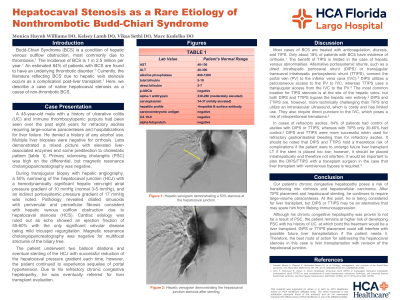Tuesday Poster Session
Category: Liver
P4701 - Hepatocaval Stenosis as a Rare Etiology of Nonthrombotic Budd-Chiari Syndrome
Tuesday, October 29, 2024
10:30 AM - 4:00 PM ET
Location: Exhibit Hall E

Has Audio

Monica A. Huynh, DO
HCA Florida Largo Hospital
Largo, FL
Presenting Author(s)
Monica A. Huynh Williams, DO1, Kelsey Lamb, DO1, Vikas Sethi, DO2, Marc Kudelko, DO1
1HCA Florida Largo Hospital, Largo, FL; 2HCA Florida Healthcare, Largo, FL
Introduction: Budd-Chiari Syndrome (BCS) occurs with hepatic venous outflow obstruction, most commonly due to thrombosis.1 Currently, the literature reflecting BCS from hepatic vein stenosis occurs as a complication post-liver transplant. Here, we describe a rare case of native hepatocaval stenosis (HCS) as a cause of nonthrombotic BCS.
Case Description/Methods: A 45-year-old male with ulcerative colitis and immune thrombocytopenic purpura has been seen over the past eight years for refractory ascites requiring large-volume paracenteses and hospitalizations for liver failure. He denied alcohol use, liver biopsies were negative for cirrhosis, and perinuclear anti-neutrophil cytoplasmic antibodies (p-ANCA) were negative. Liver enzymes demonstrated a mixed picture with some predilection to cholestatic pattern. Liver biopsy and angiography revealed 50% narrowing of the hepatocaval junction (HCJ) with a hepatocaval pressure gradient of 10 mmHg. Pathology was consistent with hepatic venous outflow obstruction due to HCS.
Over time, he underwent two balloon dilations, stenting of the HCJ, and transjugular intrahepatic portosystemic shunt (TIPS) placement with reduction of the hepatocaval pressure gradient each time, however, he still required paracenteses. Due to his refractory chronic congestive hepatopathy, he was referred for liver transplant evaluation.
Discussion: This unique case presents native hepatocaval stenosis as the underlying cause of BCS. TIPS has limited benefit in hepatic venous abnormalities. Alternative portosystemic shunts, such as direct intrahepatic portocaval shunt (DIPS) or transjugular transcaval intrahepatic portosystemic shunt (TTIPS), bypass the hepatic vein but may complicate future liver transplants.2 Given the patient’s refractory congestive hepatopathy and his increased risk of cirrhosis and hepatocellular carcinoma, DIPS or TTIPS serve as potential alternatives to liver transplant that may spare him from lifelong immunosuppression.
References:
Disclosures:
Monica A. Huynh Williams, DO1, Kelsey Lamb, DO1, Vikas Sethi, DO2, Marc Kudelko, DO1. P4701 - Hepatocaval Stenosis as a Rare Etiology of Nonthrombotic Budd-Chiari Syndrome, ACG 2024 Annual Scientific Meeting Abstracts. Philadelphia, PA: American College of Gastroenterology.
1HCA Florida Largo Hospital, Largo, FL; 2HCA Florida Healthcare, Largo, FL
Introduction: Budd-Chiari Syndrome (BCS) occurs with hepatic venous outflow obstruction, most commonly due to thrombosis.1 Currently, the literature reflecting BCS from hepatic vein stenosis occurs as a complication post-liver transplant. Here, we describe a rare case of native hepatocaval stenosis (HCS) as a cause of nonthrombotic BCS.
Case Description/Methods: A 45-year-old male with ulcerative colitis and immune thrombocytopenic purpura has been seen over the past eight years for refractory ascites requiring large-volume paracenteses and hospitalizations for liver failure. He denied alcohol use, liver biopsies were negative for cirrhosis, and perinuclear anti-neutrophil cytoplasmic antibodies (p-ANCA) were negative. Liver enzymes demonstrated a mixed picture with some predilection to cholestatic pattern. Liver biopsy and angiography revealed 50% narrowing of the hepatocaval junction (HCJ) with a hepatocaval pressure gradient of 10 mmHg. Pathology was consistent with hepatic venous outflow obstruction due to HCS.
Over time, he underwent two balloon dilations, stenting of the HCJ, and transjugular intrahepatic portosystemic shunt (TIPS) placement with reduction of the hepatocaval pressure gradient each time, however, he still required paracenteses. Due to his refractory chronic congestive hepatopathy, he was referred for liver transplant evaluation.
Discussion: This unique case presents native hepatocaval stenosis as the underlying cause of BCS. TIPS has limited benefit in hepatic venous abnormalities. Alternative portosystemic shunts, such as direct intrahepatic portocaval shunt (DIPS) or transjugular transcaval intrahepatic portosystemic shunt (TTIPS), bypass the hepatic vein but may complicate future liver transplants.2 Given the patient’s refractory congestive hepatopathy and his increased risk of cirrhosis and hepatocellular carcinoma, DIPS or TTIPS serve as potential alternatives to liver transplant that may spare him from lifelong immunosuppression.
References:
Darwish Murad S, Plessier A, Hernandez-Guerra M, et al. Etiology, management, and outcome of the Budd-Chiari syndrome. Ann Intern Med. 2009;151(3):167-175. doi:10.7326/0003-4819-151-3-200908040-00004
Artru F, Moschouri E, Denys A. Direct intrahepatic portocaval shunt (DIPS) or transjugular transcaval intrahepatic portosystemic shunt (TTIPS) to treat complications of portal hypertension: Indications, technique, and outcomes beyond Budd-Chiari syndrome. Clin Res Hepatol Gastroenterol. 2022;46(4):101858. doi:10.1016/j.clinre.2022.101858
Disclosures:
Monica Huynh Williams indicated no relevant financial relationships.
Kelsey Lamb indicated no relevant financial relationships.
Vikas Sethi indicated no relevant financial relationships.
Marc Kudelko indicated no relevant financial relationships.
Monica A. Huynh Williams, DO1, Kelsey Lamb, DO1, Vikas Sethi, DO2, Marc Kudelko, DO1. P4701 - Hepatocaval Stenosis as a Rare Etiology of Nonthrombotic Budd-Chiari Syndrome, ACG 2024 Annual Scientific Meeting Abstracts. Philadelphia, PA: American College of Gastroenterology.
